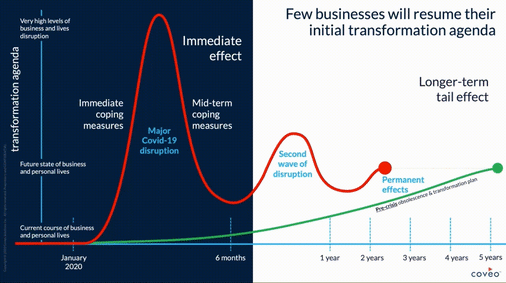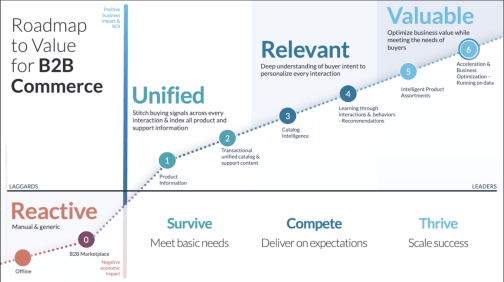Last Wednesday, Brian McGlynn (VP Commerce at Coveo) and Andy Peebler (VP B2B Commerce at Salesforce) came together for the live webinar “Are Your Digital B2B Commerce Experiences Ready for the Next Normal?”.
Brian kicked things off by touching upon the state of B2B Commerce in the context of the pandemic we face as well as the changes and challenges that have arisen as a result. His introduction culminated in a key point: the coronavirus pandemic has forced work and life online, increasing people’s expectations for a seamless experience on your digital channels, requiring you to accelerate your digital transformation in order to meet them.
Coming to understand what you need to do is important, however, it’s equally important to know how you should go about doing it. While we can’t be certain about what the new normal will look like, we do know that it will be a function of what is happening right now. And that is why Brian and Andy spent the remainder of the webinar discussing common questions regarding how to act now in order to accelerate and prepare for whatever comes your way in the new normal.
Let’s unpack each in turn.
How are companies adapting in the short term?
The COVID crisis is putting pressure on companies to move further and faster – and the initiatives they are taking right now are largely a function of the technological capabilities they had already built.
For example, those companies that had already embraced B2B Commerce and put a digital self-service channel in place are faring with increased digital demand from customers far better than those companies that did not have those capabilities to start. Their preexisting infrastructure has left them with a much narrower transformation timeline gap – the distance between the capabilities they currently possess and those that they must attain.

For those companies that didn’t have those capabilities in place, catching up is not unfeasible, but it does require that they start accelerating immediately. They don’t have to win the race to digitally transform, but they must at least build themselves up to stay in the race. If they don’t, the gap between them and digital leaders will become impossible to close, rendering them unable to deliver the seamless digital experiences that will make their customers stay.
How has this crisis begun to uncover cracks in companies’ Go To Market and Service Operations?
The effect of the coronavirus pandemic on the movement towards digital journeys and transformation can be equated to dropping napalm on a campfire – it has given rise to an explosive leap forward for many companies. And this acceleration has revealed cracks in seemingly functional capabilities, given that more demand has been placed them while traditional forms of compensation for technological shortfalls have disappeared.
Take search for example. For some companies, the search functionality on their website may not have been the best, but improving it was not a high priority as customers had support reps to lean on to answer their questions. With a greater demand being placed on contact centers, it is much harder for customers to connect with a representative when they need them, making it essential to improve search in order for customers to find the information and products they need on their own – to self-serve.

The value of self-service cannot be overstated. In fact, in a report released by Salesforce, “customer satisfaction with self-service ordering” is listed alongside “more revenue and faster growth” in the top four benefits of the Salesforce B2B Commerce solution.
Another deficiency that has been exacerbated by the current circumstances is the lack of a direct-to-customer channel for ordering and reordering. Companies are still making complex purchases through sales reps, but reorders and consumables that come via one-off orders can be just as critical to keeping operations up right now.
Although moving to develop new capabilities and get new systems up fast is important, companies need to remember that simply having a digital channel is not enough – the experience must be seamless. They need to ensure that data is consistent across all channels, especially when it comes to pricing. If prices don’t match between channels or don’t reflect negotiated pricing, customers will get frustrated and leave. Customers don’t want to have to think about whether the price is right or not – they want a sense of certainty and assurance, and that can’t be delivered if data is siloed and systems don’t speak.
Will the urgency remain or is this a short term shift?
The urgency to digitally transform and and improve self-service capabilities will undoubtedly remain. And this is largely due to the fact that this trend isn’t new.
Many companies had already been moving to boost their digital capabilities given that the demographic makeup of their customer base was changing and coming to include an increasing number of young, digital natives, each of whom carried high expectations for the digital experience. Now, with more people online that carry similarly high expectations, improving digital self-service is still the goal, but it must be achieved faster and taken further.

And in the new normal, digital self-service must be like talking to the company’s best sales rep. That best sales rep is certainly able to answer pricing questions, but they also learn from customers to suggest other products in which they may have an interest as well as provide important pre-purchase details and product documentation. Digital needs to be every bit as good as in-person experience – because that’s how people expect to interact now.
The two questions that then followed touched upon many of the same themes we’ve already explored, so I won’t address them here to avoid repetition. But if either of these sound interesting to you be sure to check out the full replay for more details: “What kind of role will online channels have in the future of service and B2B Commerce?” and “What does this shift mean for the workforce – and the customer?
What does a seamless experience look like?
Well, it looks like this:
What should your roadmap for B2B commerce look like to get ready for the next normal?
Accelerating digital transformation is certainly a daunting task, especially for a company that doesn’t know where to start.
Coveo has actually come up with a “Roadmap to Value for B2B Commerce” that outlines actionable steps that companies can take to create the unified, relevant, and valuable experiences that their customers expect today and will continue to expect tomorrow.

The first step for many is improving search functionality – customers and employees need to be able to find the products and information they need in the moments that matter. However, while that will allow companies to survive, it won’t empower them to compete and thrive. In order to do so, companies need to adopt and deploy additional capabilities that enable them to learn from individual behavior and tailor the experience to meet both the needs of their customers and their business. In other words, they need an Experience Intelligence Platform.
Coveo isn’t the only company available to help you on your way to success in B2B Commerce. Salesforce is also currently offering “Quick Start for B2B Commerce” – an all-in-one-solution that enables companies to deploy a B2B Commerce storefront for self-service ordering in as few as five weeks.
Now only one question remains, and it’s for you to answer: what are you waiting for?



